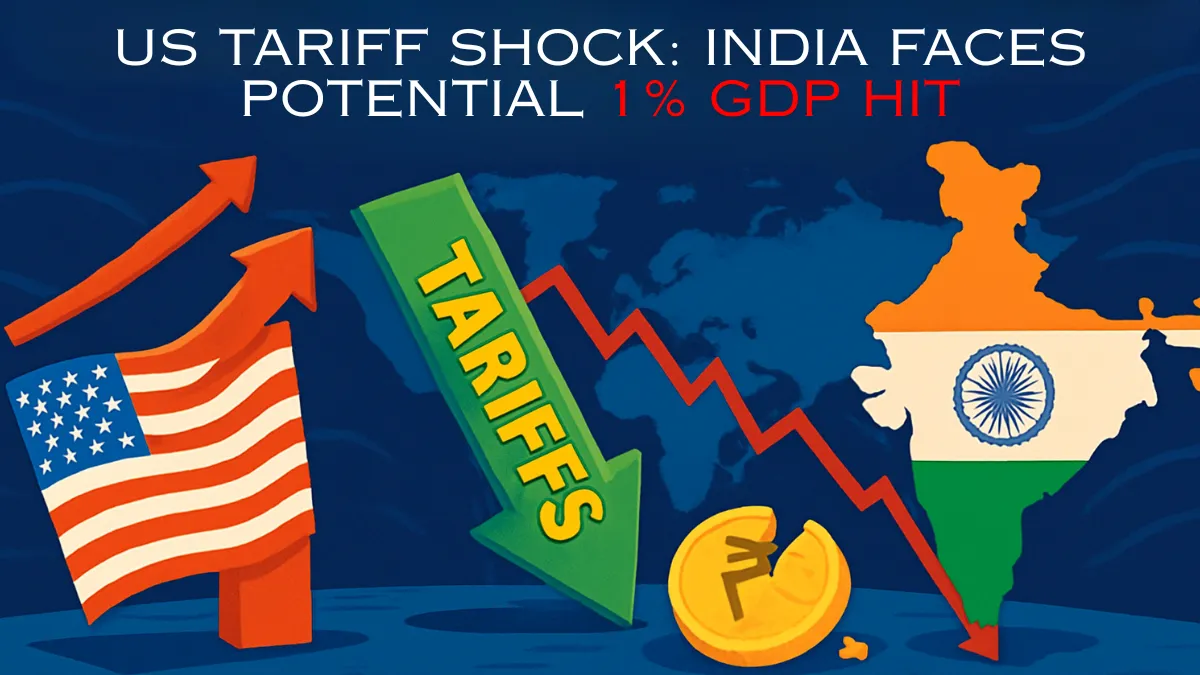The economic relationship between India and the United States has entered a turbulent phase after Washington announced a steep US Tariff hike on Indian exports. With U.S. President Donald Trump doubling tariffs from 25% to 50% on a wide range of Indian goods—primarily in response to India’s ongoing oil trade with Russia—experts warn that the move could slice up to 1% from India’s GDP growth in the coming year.
The Tariff Move and Its Context
The new US Tariff policy is seen as part of a broader U.S. strategy to exert pressure on trading partners engaged in business with Russia. India, a major energy importer, has continued to buy Russian crude at discounted rates since the start of the Ukraine conflict, citing national energy security needs. The U.S. administration views this as undercutting sanctions on Moscow, prompting an economic retaliation.
The tariff covers labor-intensive export categories such as textiles, gems and jewelry, leather goods, and certain manufactured products. Over time, it could also extend to sectors like pharmaceuticals and electronics, widening the scope of impact.
Economic Impact Estimates
Several leading global financial institutions have published projections on the likely economic fallout:
- Bloomberg Economics predicts a potential 1% GDP hit, with the medium-term effect possibly reaching 1.1% if tariffs are broadened to more sectors.
- Morgan Stanley and Jefferies estimate a GDP reduction of about 0.8% if the tariffs persist beyond a few weeks.
- Goldman Sachs offers a slightly lower estimate of 0.6%, but still warns of significant disruption to export-driven industries.
- In contrast, the PHD Chamber of Commerce and Industry (PHDCCI) remains optimistic, suggesting the overall impact could be minimal—around 0.19%—given India’s strong domestic demand and diversified economy.
Sectors Under Strain
The US Tariff shock is likely to be felt most in industries heavily reliant on the U.S. market. These include:
- Textiles & Apparel – Already facing intense competition from Bangladesh and Vietnam, Indian exporters could lose pricing competitiveness overnight.
- Gems & Jewelry – The U.S. is a top destination for India’s diamond and gold jewelry exports, meaning higher tariffs could hit profit margins sharply.
- Leather & Footwear – With tight margins and price-sensitive buyers, this sector may see a decline in orders.
- Pharmaceuticals – While not yet targeted heavily, the threat of expanded tariffs could deter future investments.
Ripple Effects Beyond Exports
The US Tariff hike’s impact is not limited to trade numbers alone. It could have secondary effects, such as:
- Investor Sentiment – Rising trade tensions may deter foreign direct investment into export-oriented industries.
- Employment – Labor-intensive sectors may be forced to cut jobs if orders decline.
- Exchange Rate Pressure – A widening trade deficit could put downward pressure on the Indian rupee.
- Stock Market Volatility – Export-heavy companies may see short-term declines in market valuation.
Government’s Possible Response
The Indian government faces a delicate balancing act. On one hand, it must safeguard its strategic energy partnerships and maintain economic autonomy. On the other, it cannot afford a prolonged trade war with one of its largest export destinations.
Potential responses could include:
- Bilateral Negotiations – Opening diplomatic channels to seek exemptions for certain sectors.
- Diversifying Export Markets – Expanding trade ties with Europe, Southeast Asia, and Africa to offset U.S. demand loss.
- Domestic Support Packages – Offering subsidies or tax relief to affected exporters.
- Strategic Energy Talks – Exploring ways to continue Russian oil imports while addressing U.S. concerns.
Global Trade Dynamics at Play
This US Tariff escalation is part of a broader global trend toward protectionism, where countries are increasingly using trade policy as a geopolitical tool. India’s situation is particularly complex because it is balancing relationships with both the U.S. and Russia, two nations currently at odds.
In the medium to long term, India may accelerate its push for self-reliance in manufacturing under the “Make in India” initiative while also boosting regional trade agreements that bypass the U.S. market altogether.
Looking Ahead
Whether the GDP hit ends up being closer to 0.2% or a full 1% will depend on several factors: the duration of the tariffs, India’s ability to find alternative markets, and the overall resilience of the domestic economy.
For now, economists agree on one point—if the US Tariff remain in place for an extended period, India’s export growth could slow sharply, impacting overall economic momentum.
In summary, the 50% U.S. tariff on Indian goods is more than just a trade dispute—it is a geopolitical signal and an economic challenge. India’s policy response in the coming weeks will be critical in determining whether the GDP slowdown is temporary or more deeply entrenched.








